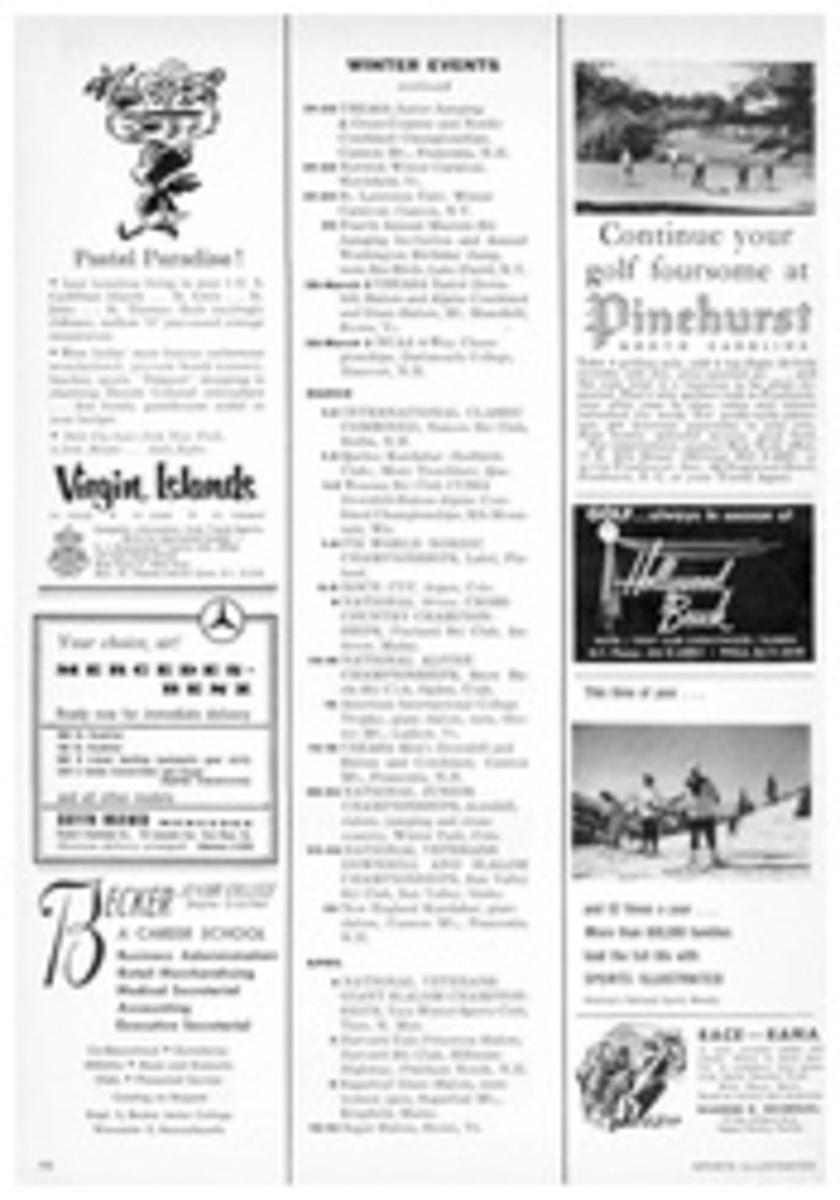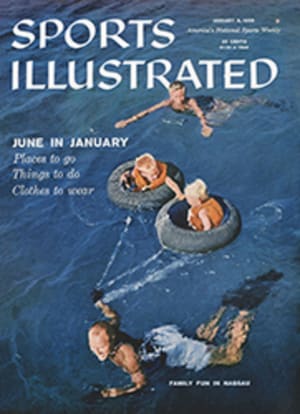
Sports Illustrated South: a 20-page compendium of vacation delights beginning here with the Travel Editor's guide to some ODD BIRDS IN FLIGHT
So many Rookerieshave sprung up across the 6,000-mile banana belt stretching from Maui toMartinique that a sun-seeker heading south in winter must decide just what sortof bird he really is. To ease the problem of selecting a place to roost untilthe icebergs melt, I have classified migratory types in a pocket-sizeddirectory known as Sutton's Sunlit Syllabus and Self-assessor. While purebredtypes are indeed rare—most sun-seekers are hybrids—a man who recognizes his ownpersonality in the tables that follow should have no trouble making theburnishment fit the clime.
THEROTO-BODY-BROILER
The garden varietyof wintertime toaster is, of course, the Roto-Body-Broiler. He sports theluminous look of a man who spent 14 years on the bridge of the freighter ChinaLady sailing fortnightly between Penang and Mandalay. If the truth be known, hehad a February week in Barbados, which he has parlayed into a winterlong tan byhiding under the barbershop sun lamp. The mere thought of losing his tan makeshim feverish. For the Broiler a sunburn has twin rewards. First, a winterweek's relaxing in the South can camouflage three months' winter dissipation upNorth. Second, there is that exquisite moment when, having returned to thefrozen wastes, he stands silently in the office until some miserable palefacefinally asks, "Good God, man, where did you get that tan?"
Roto-Body-Broilersroast the corpus in two ways, requiring the touristologist to subdivide theBroiler into two categories. The first, or inert Broiler, is the SUN FLOPPER.He throws himself down at the sight of the first palm frond. His equipment issimple: all he needs is oil, shorts, a white plastic nose guard and a ticketsouth. He nests on the settees strewn around Miami Beach swimming pools, on thenoiseless beaches of the Caribbean's Caneel Bay, alongside the swimming poolsappended to the pink palaces of Palm Springs, or on the sands of Waikiki. If hestirs, it is only for periodic basting and to toast himself evenly on bothsides. In short, his motto is Go Now, Peel Later.
A Flopper, whenwound up, becomes a SUN HOPPER. The Hopper wants to tan, but he can't liestill. He toasts while trolling for tuna off Hawaii, while pursuing thebonefish in the flats off Bimini, while stalking rare birds in the Everglades.He'll walk a fairway backwards to keep his face in the sun and, like allRoto-Body-Broilers, come Departure Day, he is the man who stands on the rampuntil they shut the plane door, chin upturned to the bountiful heavens, gettinghis last licks before flying away home.
THE DAWN-TO-DUSKDOER
Sometimes mistaken for the Sun Hopper, this type is in the sea beforebreakfast, on the links before lunch, on the courts before tea and in the sackbefore 9. All he needs, really, is a pair of sneakers. He has liniment, willtravel. But he hops pour le sport and, if he happens to get sunburned enroute,ça va. The Doer inhabits the Arizona ranches, arising before the sun forbreakfast rides into the purple canyons. He pulls lead paddle on the outriggersof Waikiki, and he is first off the tee of the Mid-Ocean Club in Bermuda.Tomorrow he may be back in the office, so he gathers his charley horse while hemay.
THE DUSK-TO-DAWNOGLER
The Ogler is the compleat spectator sportsman. He wonders why Dawn-to-DuskDoers spend the whole day jumping all over the place when they could sitcomfortably and watch someone else jump all over the place. He, for instance,has been up late watching the wheels in Havana, watching the floor show at Donthe Beachcomber's, watching the limbo dancers in Jamaica. Tomorrow he willconsult the morning line—in the afternoon. He will have breakfast at Hialeah.The only thing that will get the Dusk-to-Dawn Ogler out of bed before the dayis half shot is the prospect of a spectacular day of girl watching by the pool.He thinks the bullfights in Mexico are dandy. They don't start till 4.
THE FREE-PORTFREEBOOTER
Perhaps the easiest type to spot, the Free-Port Freebooter is a scavenger whoinhabits the duty-free metropolises of the West Indies and is often foundboarding a plane or ship carrying five bottles of duty-free rum and a hugewoven basket bulging with bongo drums, mahogany salad bowls, an old coconut, aconch shell and a set of English bone china. Recently some types have beengiven to carrying rumba or calypso boxes, hollow wooden crates fitted withsteel teeth which when twanged go "Bloom! Bloom!" Freebooters who bringhome rumba boxes in addition to bargain booze and bulging baskets usuallyappear at the airport clutching their homeward ticket in their teeth.
There are, to besure, several varieties of Free-Port Freebooters, notably the WHITE ELEPHANTHUNTER, the BLOOD-IN-THE-EYE BARGAIN BUYER and the PLACE-IN-THE-SUN DROPPER.The White Elephant Hunter is rather like a mountain climber. He buys what hebuys because it is there: a pair of maracas engraved with the lyrics of MamaDon't Want No Peas and Rice and Cocoanut Oil, a coconut sculptured to look likea hyperthyroid monkey, a candelabra made by native craftsmen of oldcondensed-milk cans. But the White Elephant Hunter is most easily recognized byhis fickle taste, a foible which has long been recognized by steamshipcompanies operating West Indies cruises. Most cruise directors designate thelast night aboard ship as White Elephant Barter Night, an evening dedicated totrading unwanted treasures only recently obtained for things a person shouldhave bought three ports ago.
Much more dedicatedis the Blood-in-the-Eye Bargain Buyer. For this type the southern seas are aShangri-La with merchandise, all of it marked down. Nassau is a place where thetrees bear Royal Doulton and the landscape is paved with Harris tweed. St.Thomas is bounded by Danish silver, Swedish glass and French perfume. And ifyou're looking for a watch, Curacao is a Dutch Switzerland with a sensibletemperature.
Although sometouristologists may disagree, the Dropper is really a breed of Free-PortFreebooter. The Dropper shows up on a New England beach in summer sporting astraw sun hat with a woven stovepipe two feet high growing out of the crown anda brim 20 inches across. When asked where he got the skimmer, thePlace-in-the-Sun Dropper replies, "Oh, this? I got it when I was in Jamaicalast winter." Place Droppers who also drop names can merely extend theanswer: "Oh, this? I got it when I was in Jamaica the time we had cocktailswith Noël."
Those who findfirst-person place-dropping too forthright may use the subtler technique ofdressing the children, when summer rolls around in the northlands, in bathingsuits embossed with calypso dancers, coconut palms and other strange designspurchased last winter in some tropical hideaway and not indigenous to FarRockaway or the Wisconsin Dells. In this case questions are likely to bedirected to the child who, when properly schooled, will reply, "Oh, thisbathing suit? Mommy and Daddy brought it back last year from Nassau."
THE SUN-KISSEDSIGHTSEER
There are many delights for the unabashed rubbernecker in the vast land of rumand rumba. He doesn't have to bring anything but himself, and all he needpossess is an unlimited appetite for the old, the historical and the curious.What a treasure for the OLDEST-WHATEVER-IT-IS FANCIER to stumble onto St.Augustine, Florida, which houses an Old Curiosity Shop, the old Spanish gates,the nation's oldest masonry fort, the oldest house in the U.S., and is, whenyou get right down to it, the oldest city in the whole country. For theCRUMBLING RUIN RAMBLER, who could ask more than a three-day excursion toYucatan, the Mexican state studded with the relics of Mayan civilization, asimposing as the monuments of ancient Egypt? Or Christophe's Citadel, high abovethe Haitian plain, where the West Indian emperor marched his soldiers to deathover the ramparts just to prove their iron discipline? For theDON'T-MISS-THE-WHATCHAMACALLIT buff, Florida is full of performing Seminoleswho wrestle alligators, performing porpoises who snaggle fish, not to mentionperforming parrots, monkeys and sea cows. And Nassau has a platoon of marchingflamingos.
THELIGHT-COMPLEXIONED METER READER
This breed migrates not for the exercise, the sunburn or the bargains. He iseasily recognizable because he travels shoulder-bent with cameras, camera bagsand light meters. Meter Readers passing one another on the trail don't exchangepleasantries; they exchange meter readings. They see the countryside throughthe view-finder, and the only place they are liable to get sunburned is on theback of the neck. Back home, the Meter Reader lures unsuspecting guests withpromises of drinks, dinner and brilliant company—then slams the door, dousesthe lights, and transforms the nearest wall into a projected image of SunriseBeach—at sunset. Asked if it was warm and sunny down south, the Meter Readeranswers, "It was perfect 100-at-f/6-on-panchromatic-with-a-K-2-filterweather."
THE LOWER-LATITUDELUSH
No one sees less and has a better time. Offered anything less than a perfectdry Martini in Twenty One, he would be aghast. Transplanted to the tropics fortwo weeks of sun, he inhales the Bacardi of Puerto Rico, the Barbancourt ofHaiti, the tequila of Mexico and, if it were still available, he would swigokoolehao in Hawaii. A moderate drinker in his natural northern habitat, forthe span of a fortnight in the friendly Fahrenheits the Lower-Latitude Lushbecomes a regular Passout Partout.
ILLUSTRATION
DUSK-TO-DAWN OGLER
ILLUSTRATION
SUN-KISSED SIGHTSEER
ILLUSTRATION
FREE-PORT FREEBOOTER
ILLUSTRATION
LOWER-LATITUDE LUSH
ILLUSTRATION
LIGHT-COMPLEXIONED METER READER
ILLUSTRATION
CRUMBLING RUIN RAMBLER
ILLUSTRATION
ROTO-BODY-BROILER

